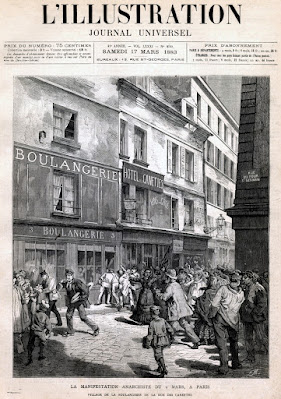Lots of people recognise the Black Flag, but not so many are aware of its origins or the thoughts behind the choice. It's a symbol that is unmistakably anarchists, but where did it come from?
Maurice Dommanget, claims Louise Michel was among the first to announce the black flag as a symbol of the anarchist movement, though there is some evidence of the Black Flag being present at earlier revolts, riots and revolutionary actions. At the twelfth anniversary of the outbreak of the Paris Commune Louise Michel made speech stating;
Maurice Dommanget, claims Louise Michel was among the first to announce the black flag as a symbol of the anarchist movement, though there is some evidence of the Black Flag being present at earlier revolts, riots and revolutionary actions. At the twelfth anniversary of the outbreak of the Paris Commune Louise Michel made speech stating;
“No more red flags, wet with the blood of our fighters. I will raise the black flag, in mourning for our dead—and for our illusions."
Newspaper coverage depicting Louise Michel at a rowdy demonstration on March 9, 1883.
An excellent article on the history of the Black Flag here on Crimethinc:
In the first article in this newspaper, entitled “The Premier of the Black Flag: To Anarchists,” the editors spelled out their aspirations:
Is there a need for a program when we take the title “The Black Flag” for our newspaper; are we not already indicating what our course of action will be? In taking this title, we were inspired by the local history of the city of Lyon, because it is on the heights of Croix-Rousse and Vaisse that the workers, driven by hunger, displayed it for the first time, as a sign of mourning and revenge, and thus made it the emblem of social demands. By taking this title, therefore, it means that we will always be on the side of the workers against the exploiters, on the side of the oppressed against the oppressors.
It is a commitment that we will not fail, taking inspiration from the campaign that our predecessors started with The Social Duty, The Revolutionary Standard, and The Struggle; we will see The Black Flag fly at the front in the assault that the anarchists carry out against this corrupt old society, which is already trembling on its foundations; an organ of struggle and combat, The Black Flag will wage war on all the abuses, all the prejudices, all the vices, all the hypocrisies, which, under the name of social institutions, are currently joining forces to delay the fall of this rotten old world, which, left to its own devices, would soon collapse under the weight of its infamies.
Supporters of absolute freedom, we will wage war on all those pseudo-liberals, makers of laws, who only understand freedom when it is well regulated, for we believe that freedom is only real if it is unhindered; we will wage war on laws, codes, judges, police officers, and all institutions, in the end, whose real goal is to restrict this freedom, which we proclaim so loudly, and to promote the exploitation of the masses by a privileged minority.
Tina Modotti, “Woman with Flag”—a photograph of a woman walking “with the black flag of the Anarcho-Syndicalists” in Mexico City in 1928.
Visit ann arky's home at https://radicalglasgow.me.uk














